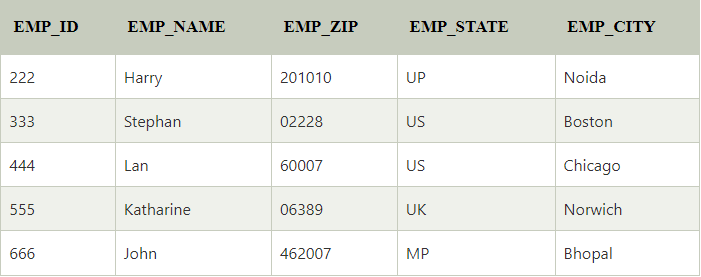Published by: Sareena Kumari Basnet
Published date: 26 Jul 2024

First Normal Form
Second Normal Form
Third Normal Form
BCNF
Fourth Normal Form
For a table to be in the First Normal Form, it should follow the following 4 rules:
It should only have single(atomic) valued attributes/columns.
Values stored in a column should be of the same domain.
All the columns in a table should have unique names.
And the order in which data is stored should not matter.
Example: Relation EMPLOYEE is not in 1NF because of multi-valued attribute EMP_PHONE.
EMPLOYEE table:

The decomposition of the EMPLOYEE table into 1NF has been shown below:

For a table to be in the Second Normal Form,
It should be in the First Normal form.
And, it should not have Partial Dependency.
Example: Let's assume, a school can store the data of teachers and the subjects they teach. In a school, a teacher can teach more than one subject.
TEACHER table

In the given table, non-prime attribute TEACHER_AGE is dependent on TEACHER_ID which is a proper subset of a candidate key. That's why it violates the rule for 2NF.
To convert the given table into 2NF, we decompose it into two tables:
TEACHER_DETAIL table:

TEACHER_SUBJECT table:

A table is said to be in the Third Normal Form when,
It satisfies the First Normal Form and the Second Normal form.
And, it doesn't have Transitive Dependency.
Example:
EMPLOYEE_DETAIL table:

In the given table, all attributes except EMP_ID are non-prime.
Here, EMP_STATE & EMP_CITY dependent on EMP_ZIP and EMP_ZIP dependent on EMP_ID. The non-prime attributes (EMP_STATE, EMP_CITY) transitively dependent on super key(EMP_ID). It violates the rule of third normal form.
That's why we need to move the EMP_CITY and EMP_STATE to the new table, with EMP_ZIP as a Primary key.
EMPLOYEE table:

EMPLOYEE_ZIP table:

Example:

To make this relation (table) satisfy BCNF, we will decompose this table into two tables, student table and professor table.
Below we have the structure for both the tables.

Example:
STUDENT

The given STUDENT table is in 3NF, but the COURSE and HOBBY are two independent entity. Hence, there is no relationship between COURSE and HOBBY.
In the STUDENT relation, a student with STU_ID, 21 contains two courses, Computer and Math and two hobbies, Dancing and Singing. So there is a Multi-valued dependency on STU_ID, which leads to unnecessary repetition of data.
So to make the above table into 4NF, we can decompose it into two tables:
STUDENT_COURSE

STUDENT_HOBBY
